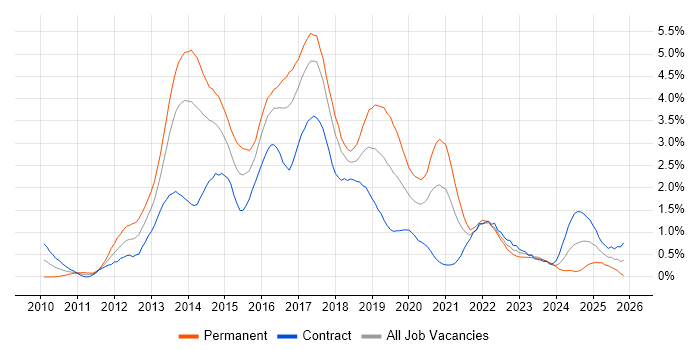CSS 3
Scotland > Glasgow
The table below provides summary statistics and salary benchmarking for jobs advertised in Glasgow requiring CSS3 skills. It covers permanent job vacancies from the 6 months leading up to 22 December 2025, with comparisons to the same periods in the previous two years.
| 6 months to 22 Dec 2025 |
Same period 2024 | Same period 2023 | |
|---|---|---|---|
| Rank | - | 78 | 115 |
| Rank change year-on-year | - | +37 | -13 |
| Permanent jobs citing CSS3 | 0 | 1 | 4 |
| As % of all permanent jobs in Glasgow | - | 0.13% | 0.40% |
| As % of the Libraries, Frameworks & Software Standards category | - | 0.80% | 1.13% |
| Number of salaries quoted | 0 | 1 | 2 |
| 10th Percentile | - | - | £48,500 |
| 25th Percentile | - | £52,000 | £50,000 |
| Median annual salary (50th Percentile) | - | £54,000 | £55,000 |
| Median % change year-on-year | - | -1.82% | +29.41% |
| 75th Percentile | - | £56,000 | £60,000 |
| 90th Percentile | - | - | £61,500 |
| Scotland median annual salary | - | £45,000 | £60,000 |
| % change year-on-year | - | -25.00% | +20.00% |
All Software Libraries and Frameworks
Glasgow
CSS3 falls under the Software Libraries and Frameworks category. For comparison with the information above, the following table provides summary statistics for all permanent job vacancies requiring technical specification, industry standards, software libraries and framework skills in Glasgow.
| Permanent vacancies with a requirement for technical specification, industry standards, software libraries and framework skills | 48 | 125 | 354 |
| As % of all permanent jobs advertised in Glasgow | 6.87% | 16.73% | 35.26% |
| Number of salaries quoted | 31 | 60 | 109 |
| 10th Percentile | £28,250 | £38,000 | £39,750 |
| 25th Percentile | £37,125 | £45,938 | £47,500 |
| Median annual salary (50th Percentile) | £52,500 | £55,000 | £60,000 |
| Median % change year-on-year | -4.55% | -8.33% | +9.09% |
| 75th Percentile | £69,375 | £70,000 | £67,500 |
| 90th Percentile | £73,750 | £76,600 | £78,750 |
| Scotland median annual salary | £60,000 | £55,000 | £62,500 |
| % change year-on-year | +9.09% | -12.00% | +5.00% |
CSS3
Job Vacancy Trend in Glasgow
Historical trend showing the proportion of permanent IT job postings citing CSS3 relative to all permanent IT jobs advertised in Glasgow.

CSS3
Salary Trend in Glasgow
Salary distribution trend for jobs in Glasgow citing CSS3.

